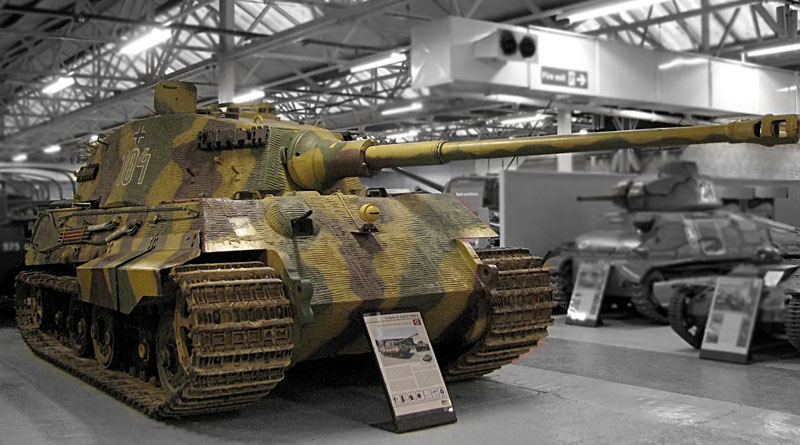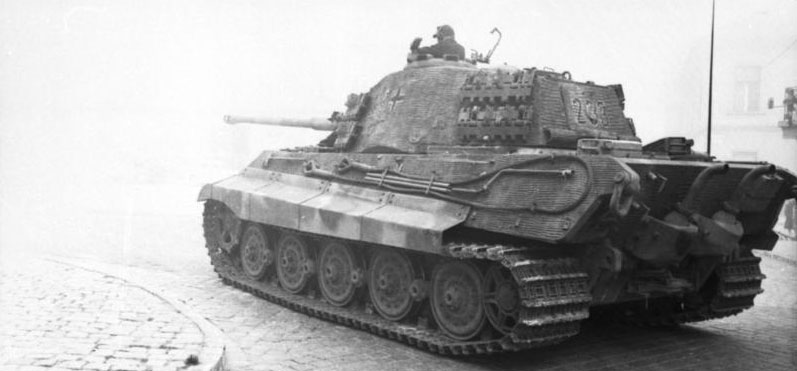The Panzerkampfwagen Tiger Ausf. B “Königstiger”, known as the Tiger II, was the largest, heaviest, and arguably the most powerful tank used in combat during World War II.
PzKpfw. Tiger II possessed immense firepower and solid armor – no Allied tank of that period (excluding the Russian IS-2) could penetrate the frontal armor of the German colossus. The phenomenal 88mm gun offered a range of up to 4 km and 100% accuracy up to 3 km, which gave the “Königstiger” an advantage over Allied machines. However, it should be noted that the Tiger II was highly prone to breakdowns, had a weak and fuel-consuming engine, and its production was very expensive. Towards the end of the war, these tanks participated in numerous engagements on both fronts but were often eliminated from combat due to malfunctions, supply shortages, or tactical errors by commanders. Despite these challenges, operational specimens were such dominant weapons on the battlefield that the Königstiger became one of the icons of armored warfare in World War II.
The Tiger II was designed to replace the highly successful PzKpfw. VI Tiger tank and, with its capabilities, neutralize the numerical advantage of Allied armored forces, especially on the Eastern Front. Two projects competed in the tender for a new heavy tank for the German army – one by Henschel and the other by Ferdinand Porsche. Ultimately, the Henschel solution was chosen, and after quick testing, mass production of the vehicle began in January 1944, during the final phase of the war.
The new tank was named Königstiger, meaning the Bengal Tiger in German (often mistakenly, literally translated as the Royal Tiger).
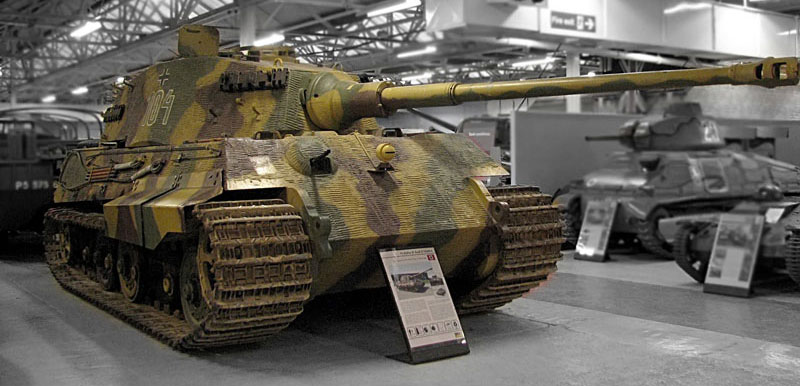
Source: Hohum, via Wikimedia Commons
With the vast expanses of the Eastern Front in mind, which were supposed to be a kingdom for the Tiger II, the focus during the tank’s development was on firepower and durable armor. The German armored colossus was equipped with the 8.8 cm KwK 43 L/71 gun, an elongated version of the 8.8 cm gun known from the Tiger tank – a gun considered the best during World War II. It was characterized by excellent accuracy and tremendous firepower. The Königstiger had no equal in this field – from a distance of up to 3 km, it could penetrate virtually any enemy tank while being able to fire 9 rounds in just 35 seconds.
Externally, the Tiger II had a silhouette resembling that of the Panther. The most vulnerable areas to enemy fire were significantly thickened and sloped, designed to facilitate ricocheting of projectiles. The front armor plate, which was sloped at a 50-degree angle and had a thickness of up to 180 mm, was never penetrated during combat! However, it should be noted that although projectiles did not penetrate the tank’s armor, the interior of the vehicle experienced spalling and cracks, which posed a significant danger to the crew. This weaker steel composition was a result of Germany’s loss of access to sources of molybdenum, and its replacement with vanadium, which proved to be a serious mistake.
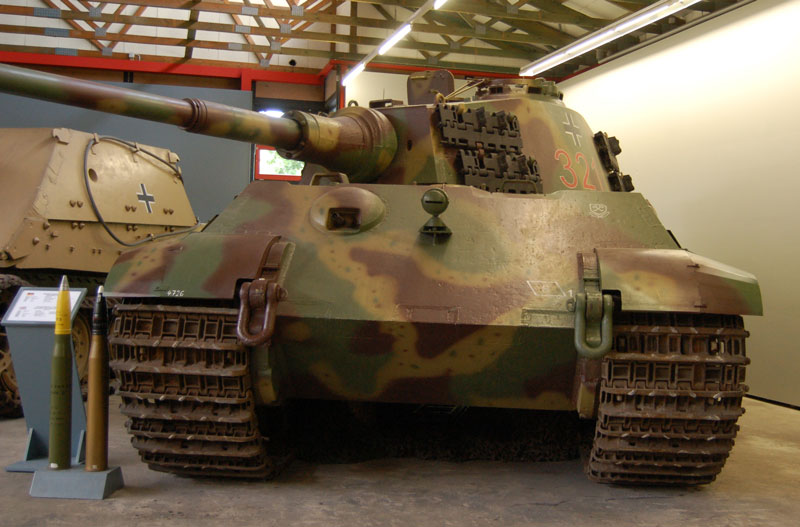
Source: Huhu via Wikimedia Commons
The Tiger II weighed almost 70 tons and this enormous weight made it too heavy to cross many European bridges without first strengthening them. The tank was equipped with a 690-horsepower Maybach engine, which was already used in the Panther at the time, but it was too weak for a tank as big as the Königstiger. In addition, the unit had an incredibly high fuel consumption (500 liters per 100 km with an 860-litre tank) and refueling the vehicle was a real challenge for the waning Third Reich. For this reason, and also because of supply problems, it happened that crews were forced to abandon their machines during the fighting. The problem was that they were so heavy and huge tanks that only another Tiger could tow a damaged Tiger II.
The new tanks were first used in combat on July 18, 1944, in Normandy against British forces. Two of them were quickly destroyed, and one – the command vehicle – fell into a bomb crater and got stuck. This was the first Tiger II captured by the Allies.
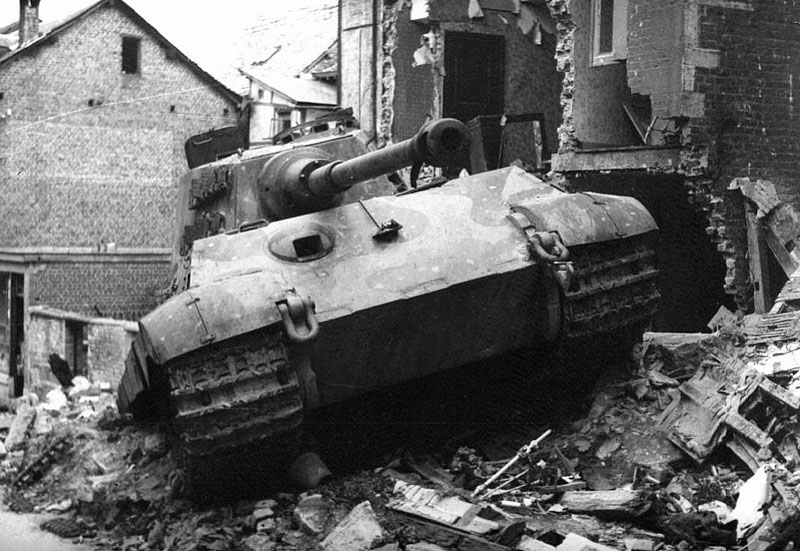
Source: US Army via Wikimedia Commons
In English: A few months later, the Tiger II tanks were part of the German armored fist during the Ardennes offensive, and although their losses were significant, they were more due to supply shortages and difficult weather conditions rather than enemy fire. The vehicles themselves performed well, as thanks to their firepower and thick armor, they could brutally force their way through the Allies’ defensive lines. The Allies had to mostly use anti-tank mines, bombs, and bazookas to immobilize Hitler’s armored monsters, as few guns could penetrate the armor of the Königstiger.
Ultimately, on the Western Front, the Königstiger tanks were stopped by mechanical failures, gaps in crew training, the use of 250-500 kg bombs by the Allies (after which the massive tanks could end up as in the photo below), as well as by the RAF’s Hawker Typhoon fighter-bombers, known as “tank hunters”.
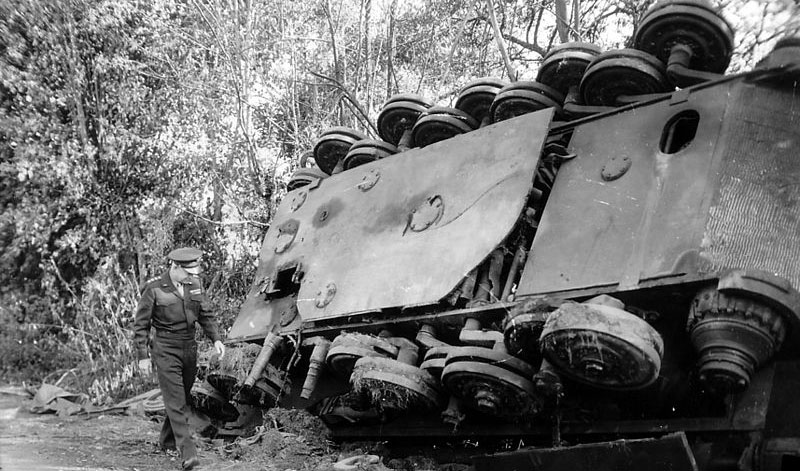
Source: Acme News Photos, Public domain
On the Eastern Front, the Tiger II did not have a successful start of combat operations. On August 12, 1944, near the village of Oględów, three new German tanks were destroyed during an ambush conducted by a single T-34/85 and infantry platoon (the tank commander, Aleksandr Oskin, was awarded the Gold Star of the Hero of the Soviet Union for this action). During fighting in that area, the Germans lost 14 more Tiger IIs, mostly in ambushes using IS-2 tanks and ISU-122 guns.
However, shortly afterwards, in October 1944, the Tiger IIs from the 503rd Heavy Panzer Battalion participated in Operation Panzerfaust, the pacification of Hungary. During 166 days of fighting in Hungary, these vehicles destroyed at least 121 Soviet tanks, 244 guns and artillery pieces, five airplanes, and one train. The losses amounted to 25 machines – 10 of them were lost in combat with the Soviets, 2 were sent for repairs, and 13 were destroyed by their own crews – due to malfunctions or supply shortages.
The Americans, after inspecting the captured Königstigers, stated that they completely did not understand the reasons that guided the German command during the design of these monsters. The Tiger II was too heavy for its engine, too large, and too slow (in the Ardennes, they could block entire roads and thus delay their own forces’ offensive). Additionally, the unit cost of producing one vehicle was astronomically high – the cost of producing one Tiger II was equivalent to the cost of ten T-34s (in conversion: $320,000 versus $31,000 for one tank).
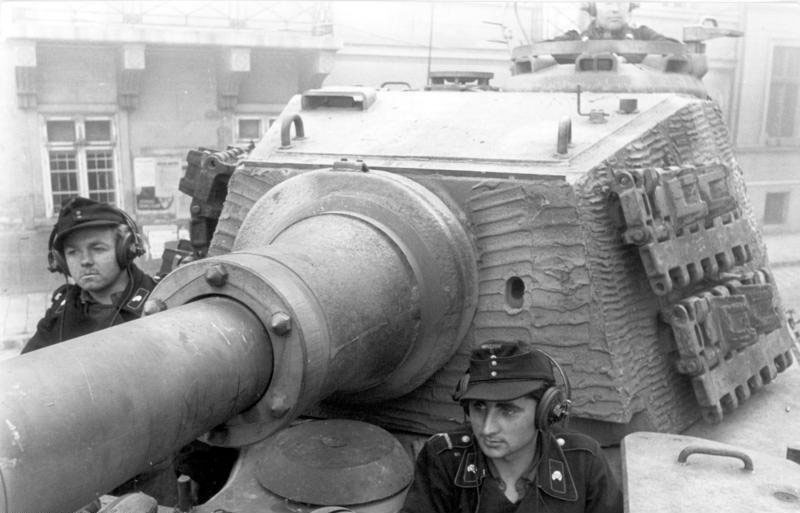
Source: Das Bundesarchiv via Wikimedia Commons
Did the Königstiger deserve the title of the most powerful tank of World War II? Fully fueled, functional units driven by trained crews could truly dominate the battlefield, especially on the Eastern Front, where vast spaces gave the Tiger II an advantage over enemy tanks. Towards the end of the war, the last giant of the Panzerwaffe could really have only two worthy competitors: the American M-26 Pershing and the Soviet IS-2. The slightly lighter (46 tons) and less heavily armored Pershing would probably have to give way to the Tiger II, but the case with the IS-2 was not so simple. Stalin’s latest tank, equipped with a 120mm gun, theoretically had the ability to penetrate the armor of the German colossus from a shorter distance. In turn, the Königstiger with its terrifying, sniper-like 88mm gun, could keep everyone, including the IS-2, at a distance and perhaps destroy it before it could fire a shot. Regardless, the 492 PzKpfw. Tiger II “Königstiger” tanks produced by the Third Reich were too few in number compared to nearly 4,000 IS-2s produced; however, if World War II had lasted longer, the German monster would have had a chance to confront the British Centurion – one of the most successful tanks of the 20th century.

